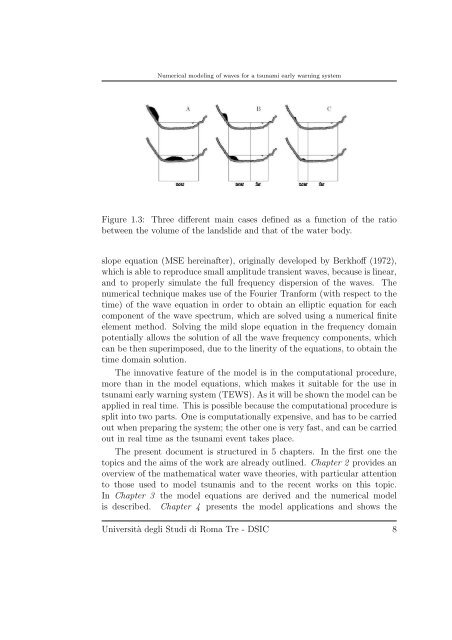Numerical modeling of waves for a tsunami early warning system
Numerical modeling of waves for a tsunami early warning system
Numerical modeling of waves for a tsunami early warning system
Create successful ePaper yourself
Turn your PDF publications into a flip-book with our unique Google optimized e-Paper software.
<strong>Numerical</strong> <strong>modeling</strong> <strong>of</strong> <strong>waves</strong> <strong>for</strong> a <strong>tsunami</strong> <strong>early</strong> <strong>warning</strong> <strong>system</strong><br />
Figure 1.3: Three different main cases defined as a function <strong>of</strong> the ratio<br />
between the volume <strong>of</strong> the landslide and that <strong>of</strong> the water body.<br />
slope equation (MSE hereinafter), originally developed by Berkh<strong>of</strong>f (1972),<br />
which is able to reproduce small amplitude transient <strong>waves</strong>, because is linear,<br />
and to properly simulate the full frequency dispersion <strong>of</strong> the <strong>waves</strong>. The<br />
numerical technique makes use <strong>of</strong> the Fourier Tran<strong>for</strong>m (with respect to the<br />
time) <strong>of</strong> the wave equation in order to obtain an elliptic equation <strong>for</strong> each<br />
component <strong>of</strong> the wave spectrum, which are solved using a numerical finite<br />
element method. Solving the mild slope equation in the frequency domain<br />
potentially allows the solution <strong>of</strong> all the wave frequency components, which<br />
can be then superimposed, due to the linerity <strong>of</strong> the equations, to obtain the<br />
time domain solution.<br />
The innovative feature <strong>of</strong> the model is in the computational procedure,<br />
more than in the model equations, which makes it suitable <strong>for</strong> the use in<br />
<strong>tsunami</strong> <strong>early</strong> <strong>warning</strong> <strong>system</strong> (TEWS). As it will be shown the model can be<br />
applied in real time. This is possible because the computational procedure is<br />
split into two parts. One is computationally expensive, and has to be carried<br />
out when preparing the <strong>system</strong>; the other one is very fast, and can be carried<br />
out in real time as the <strong>tsunami</strong> event takes place.<br />
The present document is structured in 5 chapters. In the first one the<br />
topics and the aims <strong>of</strong> the work are already outlined. Chapter 2 provides an<br />
overview <strong>of</strong> the mathematical water wave theories, with particular attention<br />
to those used to model <strong>tsunami</strong>s and to the recent works on this topic.<br />
In Chapter 3 the model equations are derived and the numerical model<br />
is described. Chapter 4 presents the model applications and shows the<br />
Università degli Studi di Roma Tre - DSIC 8

















